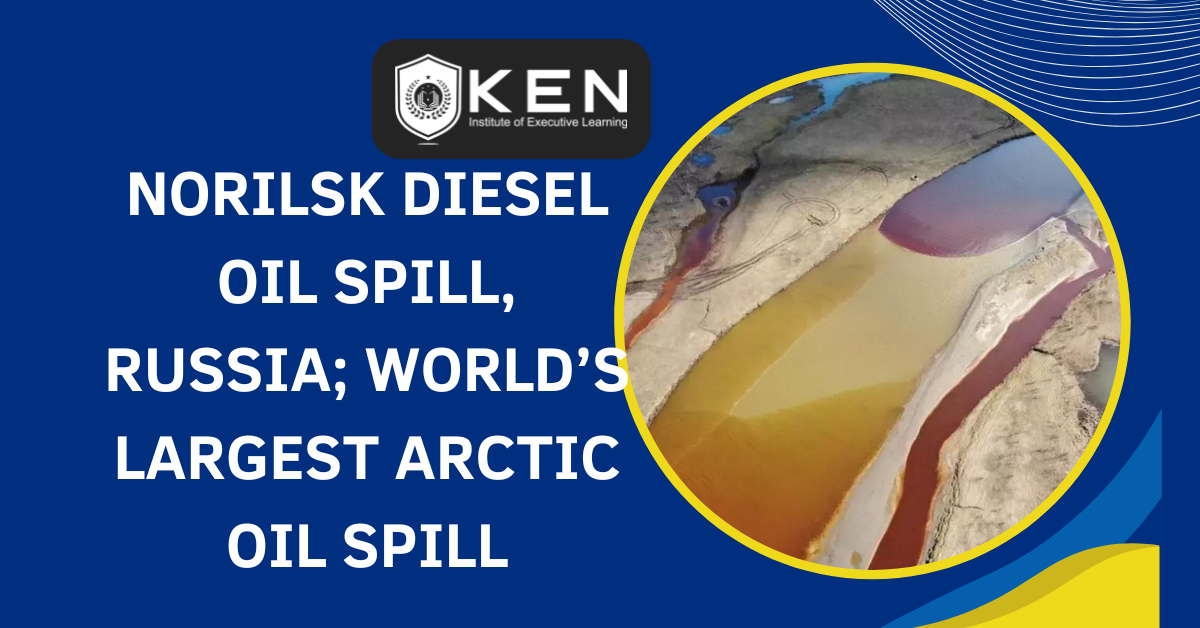ABSTRACT
The Norilsk diesel oil spill is an ongoing industrial disaster near Norilsk, Krasnoyarsk Krai, Russia.
It began on 29 May 2020 when a fuel storage tank at Norilsk-Taimyr Energy’s Thermal Power Plant No. 3 (owned by Nornickel) failed, flooding local rivers with up to 17,500 tonnes of diesel oil. President Vladimir Putin declared a state of emergency in early June 2020.
CAUSE OF THE OIL SPILL
Diesel oil is used as a backup fuel for the Norilsk-Taimyr Energy coal-fired combined heat and power plant. Fuel storage Tank 5 failed due to holes at the tank bottom, caused by the formation of ulcerative corrosion.
In 2014 the company had been ordered by the Russian Regulatory Agency for Natural Resources Rostekhnadzor to, clean the outer surface of the walls and roof of the tanks from rust restore the anticorrosion coating by 2015, to conduct non-destructive inspection of the tank bottoms by October 2016. Despite these requests from the Russian Government, Norilsk-Taimyr Energy did not take the requested steps to avoid a failure of Tank 5.

SPREAD AND CLEAN-UP: THAT WOULD TAKE FIVE TO TEN YEARS
Up to 21,000 cubic meters (17,500 tonnes) of diesel oil spilled onto the ground and into local rivers, affecting an immediate area of 18 hectares (44 acres), the nearby Daldykan River, a tributary of the Ambarnaya River, and contaminating an area of 350 square kilometers (140 square miles).
Clean-up efforts were anticipated to be difficult as there are no roads and the rivers are too shallow for boats and barges.

It was estimated the immediate cost of emergency relief activities would be 10 billion roubles (US$146 million), with a total clean-up cost of 100 billion roubles (US$1.5 billion).
As of July 6, Nornickel, the mining company that owned the storage tank, says it has removed 185,000 tonnes of contaminated soil (about 14 times the weight of the Brooklyn Bridge). The soil is being stored on-site to be “cleaned” by certified contaminant experts by early September.
The “cleaned” soil will then likely be returned to its original site. Also, 13 Olympic swimming pools’ worth of fuel-contaminated water has been pumped from the river to a nearby industrial site where harmful chemicals will be separated and the “clean” water will likely be returned to the river.
AFTERMATH
On 4 June 2020 Russian state television reported that the spill had been contained using a series of specially constructed booms on the Ambarnaya river. However, drifting ice broke the booms and the spill reached Lake Pyasino, threatening the Pyasina River, which flows into the Arctic Ocean.
Russia’s Prosecutor General‘s office ordered safety checks at all dangerous installations built on the permafrost in Russia’s Arctic.
ECOSYSTEM DISTURBANCE AND POLLUTION
In 2017, Russia’s Federal State Statistics Service listed Norilsk as the most polluted city in Russia.
“Diesel oil contains between 2,000 and 4,000 types of hydrocarbon (the naturally occurring building blocks of fossil fuels), which break down differently in the environment. Typically, 50% or more can evaporate within hours and days, harming the environment and causing respiratory problems for people nearby”.
Other, more resistant chemicals can bind with algae and microorganisms in the water and sink, creating a toxic sludge on the bed of the river or lake. This gives the impression that the contamination has been removed and is no longer a threat. However, this sludge can persist for months or years.

HOW DIFFERENT PARTS OF THE ECOSYSTEM RESPOND
At the bottom of the food chain in rivers and lakes are microscopic plants and algae that need sunlight to create energy through photosynthesis. When oil first enters the water it sits on the surface and forms a sort of oily sunblock, and so these organisms rapidly decrease in number. Zooplankton (tiny animals) that feed on them also eventually die off.
Over time, wind and currents help disperse this oily layer, but some oil will sink to the bottom and, with their predators diminished, algae will return in even greater numbers.

In the Soils in the Russian Arctic harbor where the ground is often frozen, fewer organisms than elsewhere in the world, occur due to cold, harsh conditions. liquid water is scarce and there are few nutrients available. But nonetheless, these soils are still teeming with life and badly affected by oil spills.
Initially, oil coats soil particles, reducing their ability to absorb water and nutrients, negatively affecting soil organisms as they are unable to access food and water essential for survival. This oily coat can last for years as it is very hard to wash off, so often the soil has to be physically removed. Yet toxins will likely remain in both the water and soil. Over months and years, these toxins will build up within the food chain, starting with the microscopic organisms and eventually causing health problems in larger organisms such as fish and birds.
Normally, cold Arctic conditions hinder microbial activity and biodegradation. The current Arctic heat wave may speed up this process initially, enabling oil-degrading microorganisms to grow, reproduce, and consume these contaminants more rapidly than normal. But due to the region’s lack of water and the nitrogen and phosphorous needed for growth; even a heat wave can only help these microorganisms so much.
ALLEGATIONS
Russian authorities have blamed the collapse on the poor state of the fuel tank and have requested Nornickel pay “voluntary compensation” for environmental damage. Nornickel denies negligence and says the fuel tank failed due to rapidly thawing permafrost.
Russia’s Investigative Committee has launched a criminal investigation into the spill.
The head of the power plant’s boiler-turbine workshop was placed in pre-trial detention, charged with violating environmental regulations and negligence.
Yevgeny Zinichev, head of Russia’s Emergency Situations Ministry, stated that the power plant did not report the incident for two days while trying to contain the situation on its own.
President Vladimir Putin declared a regional state of emergency following the spill and criticized the local authorities for a slow response.
Putin ordered officials to amend Russian law to prevent similar accidents in the future.
In a 3 June 2020 televised meeting devoted to disaster management, Putin asked Sergei Lipin, the head of NTEK: “Why did government agencies only find out about these two days after the fact? Are we going to learn about emergencies from social media?”
In June 2020, Rosprirodnadzor asked Norilsk to pay 148 billion rubles to cover damage caused by the massive spill, but Norilsk disagreed with the value.
In February 2021, a court ordered Norilsk to pay US$2 billion (146 billion rubles) for the spill. Norilsk Nickel is to pay the costs.
Without more stringent regulations to improve existing infrastructure, more spills are likely to occur, especially given how rapidly permafrost is melting in these areas causing unstable ground.
“While nature and her oil-degrading microbial communities can help clean up our mess, we should avoid relying on a largely invisible force that we don’t fully understand to fix a much larger human-generated problem.”
To enhance your insight around health and safety topics, join us at info@keninstitute.com
visit our website at www.keneducation.in
call +917569034271
Let’s connect on Facebook, YouTube, Linkedin, and Instagram.


